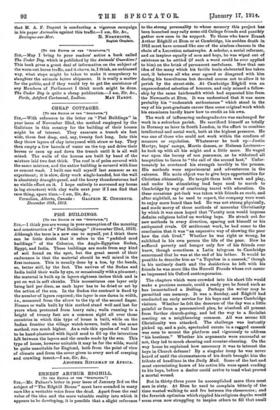Pat BUILDINGS.
[To ran Eons. or raz "Bract/moo:1
Sin,-1 think you are wrong in your oonception of the meaning and construction of "Pied Buildings" (November 22nd, 1913). Although the term is a new one to myself, yet I think there can be little doubt that it refers to the "paddled mud buildings" of the Colonies, the Anglo-Egyptian Sudan, Egypt, and India. These buildings are made from any kind of soil found on the spot, but the great secret of their endurance is that the material should be well mixed in the first instance. This is usually done by a hoe, by the hands, or, better still, by the feet. The natives of the Sudan and India build their walls by eye, or occasionally with a plummet; the material is built up in layers eighteen inches thick and is put on wet in soft chunks. This necessitates one layer only being laid per diem, as each layer has to be dried or set by the action of the Bun. In the Sudan the contract is fixed by the number of layers required; the layer is one daraa in width, i.e., measured from the elbow to the tip of the second finger. Houses or walls built by this method stand well and last for years when protected from heavy rain; walls running to a height of twenty feet are a common eight all over those countries in which this type of house is built, while on the Indian frontier the village watch-towers, built on the same method, ran much higher. As a rule this species of wall has to be band-plastered with liquid mud to fill up the interstices left between the layers and the cracks made by the sun. This type of house, however suitable it may be for the wilds, would be quite unsuitable for England, both from the point of view of climate and from the cover given to every sort of creeping and crawling insect.—I am, Sir, &c.,
ANOTHER. RIFLEMAN IN AFRICA.










































 Previous page
Previous page